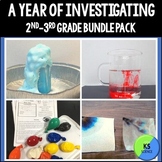Diffusion In Liquids Science Experiment | Properties of Matter | Grade 2 3
- PDF
- Easel Activity
Also included in
- This hands-on experiment bundle investigates diffusion and thermal energy with multiple grade levels. Students will use the scientific method to expand their knowledge of the properties of matter. Perfect for a science lab teacher, multigrade classroom, and differentiating for abilities.Included inPrice $11.84Original Price $14.80Save $2.96
- Bundle, Save and Meet the Standards. Discover 8 investigation units plus over 30 demonstrations. These lab activities guide students to discovery. Save yourself time searching for hands-on activities. Explore weather, chemistry, plants, health, the properties of matter, and more. Memorable labsPrice $37.80Original Price $47.25Save $9.45
Description
Engage in a hands-on science experiment that explores the flow of liquids and thermal energy. The experiment includes a complete teacher guide and uses inexpensive supplies. You can make it a complete week of lessons with the further exploration and an anchor chart.
This Hands-On Exploration Includes
- Teacher Background and Tips
- Correlation to NGSS
- 6-Page Student Investigation Journal
- Exploration Station Activity with Worksheet
- Anchor Chart
- Investigation Rubric
- Answer Keys
This Science Exploration meets the Next Generation Science Standards
- NGSS Science and Engineering Practices K-2 and 3-5
- NGSS Matter and Its Interactions Grade 2
Students will use the scientific method to discover the effects of temperature on the diffusion of food coloring in water. They will observe molecules moving, and learn how to rank their observations. They will record observations and data, create a graph, summarize, and write a conclusion at their grade level. Students will expand their knowledge by exploring food coloring in other liquids in activity 2. Students will have a positive learning experience.
Teachers will enjoy immersing students in the scientific method. Teachers like the ease of use, background information, simple supplies, and ability to use it with their curriculum.
Great for science fairs, classrooms, clubs, or science camps.
Supplies Needed
Beakers or Heatproof Containers, Food Coloring, Stopwatch, Water, and liquids of choice for activity 2 (corn syrup, oil, milk, soda, etc.).
This investigation is part of a series. This is the 2nd/3rd-grade version. Please visit each grade-level product to see the specific details.
Water and Food Dye Experiment | Properties of Matter | Scientific Method K 1
Diffusion Lab: Investigate the Rate of Diffusion with 4th/5th Grade
Diffusion Lab: Investigate the Rate of Diffusion with 6th/7th/8th Grade
Save 20% with the BUNDLE
Diffusion Lab Bundle: All 4 science journals. K-8th Grade
You might also like
Borax Crystal Lab: Investigate the Type of Water on Crystal Growth Grade 2/3
Vascular and Nonvascular Plants | Water Transportation | Grade 2 3 Science
Forces And Motion Unit | Grade 2 And 3 Newton's Cradle Science And STEM
Remember, leaving feedback earns you points toward FREE TPT purchases. We would love to hear how the investigation went.
Also, follow us and be notified when new explorations are uploaded and deals.
Please contact us with any questions! We are here to help.
Yours in Science,
Kimberly Scott
All parts are copyrighted. Please see the Terms of Use in the download.








